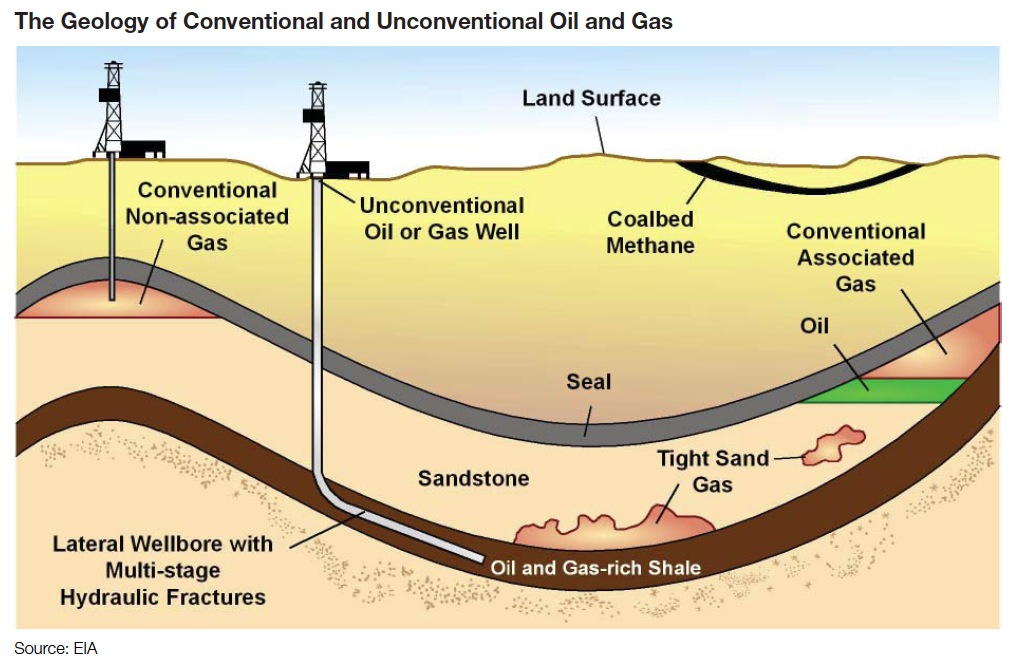SHALE OIL AND GAS
Although the terms shale oil-gas and tight oil -gas are often used interchangeably in public discourse, shale formations are only a subset of all low permeability tight formations, which include sandstones and carbonates, as well as shales, as sources of tight oil production. Within the United States, the oil and natural gas industry typically refers to tight oil production rather than shale oil production, because it is a more encompassing and accurate term with respect to the geologic formations producing oil at any particular well. EIA has adopted this convention, and develops estimates of tight oil production and resources in the United States that include, but are not limited to, production from shale formations.
Shale oil and gas are unconventional oil produced from oil shale rock fragments by pyrolysis, hydrogenation, or thermal dissolution. These processes convert the organic matter within the rock (kerogen) into synthetic oil and gas. The resulting oil can be used immediately as a fuel or upgraded to meet refinery feedstock specifications by adding hydrogen and removing impurities such as sulfur and nitrogen. The refined products can be used for the same purposes as those derived from crude oil.

Conventional natural gas reservoirs form when gas travels from organic rich rock and becomes trapped by a layer of impermeable rock above it. Producers can access the gas by drilling vertical wells into the area where the gas is present, allowing it to flow to the surface.
Shale gas resources, by contrast, are contained within relatively impermeable source rock, meaning that the gas does not migrate out of the source rock and into a reservoir where drillers can easily access it. Instead this gas and oil is accessed using the techniques of vertical and horizontal drilling, coupled with hydraulic fracturing to open fissures in the rock, allowing the hydrocarbons to flow to the surface. Onshore hydraulic fracturing is a relatively rapid process, taking a matter of months from initial site development to production. Producers are therefore nimble: they can ramp up production quickly, compared with conventional production. That allows them to be more responsive to oil and gas prices.
However, production requires capital to maintain output, especially in the case of shale oil and gas as a result of their high decline rates. That creates the usual competition for cash flows, between servicing debt and maintaining production.
The main production stages in shale oil and gas production are as follows.
Initial construction includes development of access roads and a well pad, and takes about four weeks.
Vertical drilling can take up to two weeks per vertical well; there may be several vertical wells on each well pad.
Horizontal drilling involves the transport and assembly of a larger, horizontal drilling rig on site; this is followed by drilling, and the insertion of cement casing around the well, which can take up to six weeks per well.
Hydraulic fracturing will include the removal of the drilling rig and transport of fracking fluids and sand to the site, followed by hydraulic fracturing, which involves pumping sand and fluids into the well. This can take up to nine weeks per well.
Flow-back treatment involves transfer of flow-back fluids to pits or tanks, and their ultimate removal by truck or pipeline to disposal facilities, and can take up to 14 weeks per well.
Well clean-up and testing will involve well flaring and monitoring, preparatory to production, and takes up to four weeks per well.
Well production requires the installation of pipelines to a centralized compression facility serving several well pads. Production typically declines rapidly in the first few months, while continuing at lower levels for up to several years.
Well abandonment, at the end of operation, is where the well is taken out of service and capped with a surface plug.


